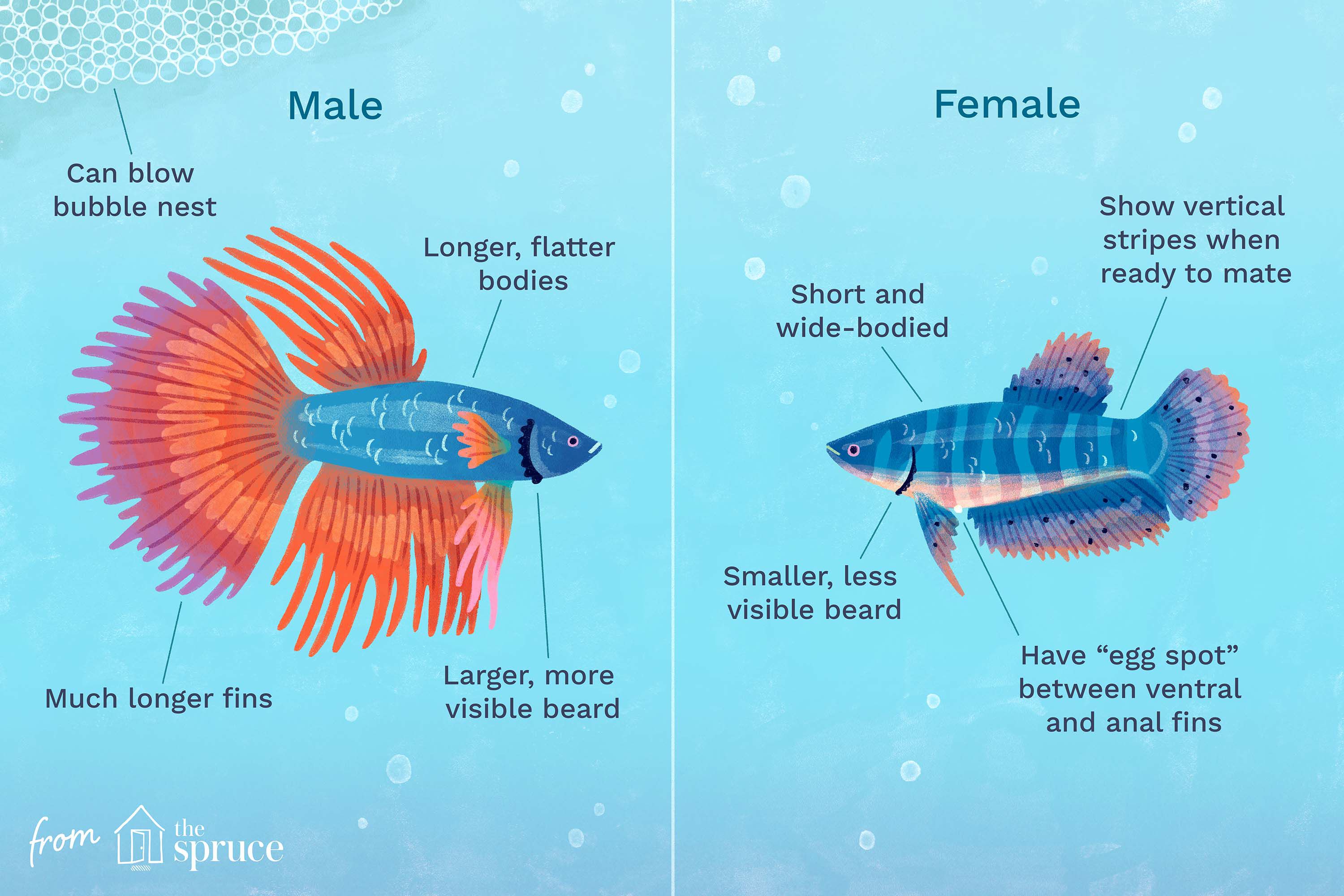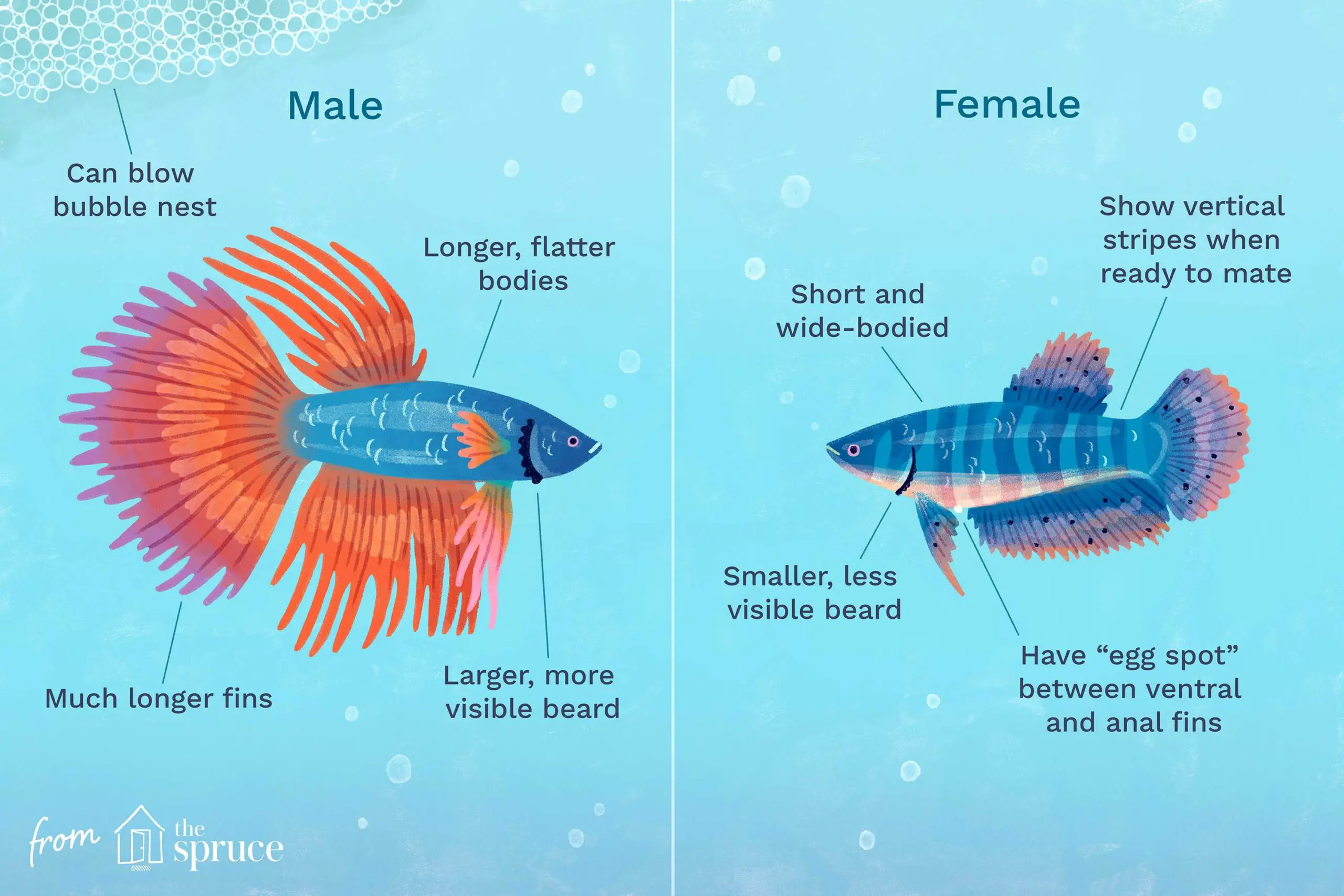Betta fish are one of the most popular aquarium fish due to their vibrant colors and unique personalities. However, it can be challenging to determine whether your betta fish is male or female. Identifying the gender of your betta fish is crucial for breeding, tank compatibility, and overall care. In this article, we will explore the various physical and behavioral differences between male and female betta fish, so you can confidently determine the gender of your beloved pet.
- Look at the size and shape of the betta’s body. Males usually have a larger, more elongated body shape than females.
- Observe the fins of the betta. Males have larger and more elaborate fins, while females have smaller and simpler fins.
- Look for a visible egg spot on the female’s underside. This is a small, white dot that indicates the presence of eggs.
- Watch the behavior of the bettas. Males are typically more aggressive and territorial, while females are more docile and social.

How to Know if Betta Fish is Female or Male?
Betta fish, also known as Siamese fighting fish, are a popular choice for aquarium enthusiasts. They are not only beautiful to look at but also have unique personalities. One of the most important things to know about your betta fish is whether it is male or female. This knowledge can help you to provide the appropriate care and can also help you to breed them. Here are some tips to help you determine the sex of your betta fish.
Physical Characteristics of Male Betta Fish
Male betta fish are known for their bright colors and long fins. They are also larger in size than female betta fish. Male bettas have a pointed ventral fin, which is used to fertilize the eggs during breeding. They also have a line called the “egg spot” on their abdomen, which is actually a false egg used to attract females during breeding.
To determine if your betta fish is male, look for the following physical characteristics:
- Bright colors
- Long fins
- Pointed ventral fin
- Egg spot on abdomen
Physical Characteristics of Female Betta Fish
Female betta fish are not as colorful or as large as male betta fish. They have shorter fins and are generally more subdued in color. Female bettas have a rounded abdomen, which is the area where the eggs are stored. Unlike male bettas, they do not have a pointed ventral fin or an egg spot.
To determine if your betta fish is female, look for the following physical characteristics:
- Less vibrant colors
- Shorter fins
- Rounded abdomen
Behavioral Differences between Male and Female Betta Fish
In addition to physical characteristics, male and female betta fish also exhibit different behaviors. Male bettas are known for their aggression and territorial behavior. They will flare their fins and gills to intimidate other fish and even their own reflection. Female bettas, on the other hand, are more social and can be kept in groups with other female bettas.
To determine if your betta fish is male or female based on behavior, observe the following:
- Aggression towards other fish or their own reflection (male)
- Social behavior and ability to be kept in groups (female)
Breeding Betta Fish
If you are interested in breeding betta fish, it is important to know the sex of your fish. Breeding bettas is not as simple as putting a male and female together and waiting for them to mate. There are several factors to consider, such as the water temperature, pH level, and the appropriate breeding area. It is also important to ensure that the female is in good health and ready to breed.
To successfully breed betta fish, consider the following:
- Ensure that the male and female are of breeding age
- Provide an appropriate breeding area
- Maintain the appropriate water temperature and pH level
- Ensure that the female is in good health and ready to breed
Benefits of Knowing the Sex of Your Betta Fish
Knowing the sex of your betta fish can help you to provide the appropriate care and environment for your fish. Male and female bettas have different needs and behaviors, so knowing their sex can help you to cater to those needs. Additionally, if you are interested in breeding betta fish, you will need to know the sex of your fish to ensure successful breeding.
Male vs Female Betta Fish
While both male and female betta fish can make great pets, there are some differences to consider when choosing between the two. Male bettas are more colorful and have longer fins, which can make them more visually appealing. However, they are also more aggressive and may need to be kept alone. Female bettas are more social and can be kept in groups, but they are not as visually striking as male bettas.
Consider the following when deciding between a male or female betta fish:
- Color and fin length (male)
- Aggression and need for solitary housing (male)
- Social behavior and ability to be kept in groups (female)
Conclusion
Determining the sex of your betta fish is an important step in providing the appropriate care and environment for your fish. Male and female bettas have different physical characteristics and behaviors, so it is important to be able to distinguish between the two. Additionally, knowing the sex of your betta fish can help if you are interested in breeding them. With these tips, you should be able to determine the sex of your betta fish with ease.
Frequently Asked Questions
Betta fish are one of the most popular pet fish. However, identifying the sex of your betta fish can be challenging, especially for new betta owners. In this article, we will answer the five most frequently asked questions about how to know if your betta fish is female or male.
Question 1: What are the physical differences between male and female betta fish?
The most noticeable physical difference between male and female betta fish is the size and shape of their fins. Male bettas have larger and more colorful fins, while female bettas have smaller and more rounded fins. Additionally, male bettas have a longer and more pointed dorsal fin than female bettas.
Another difference is that male bettas are generally more aggressive and territorial than female bettas. They may flare their fins and display aggressive behaviors towards other fish, while female bettas are more peaceful and can live together in small groups.
Question 2: Can you tell the sex of a betta fish by its color?
No, the color of a betta fish does not determine its sex. Both male and female bettas can have bright and vibrant colors. However, male bettas tend to have more intense and striking colors, especially on their fins, as a way to attract a mate.
There are some specific color patterns that can indicate the sex of a betta fish, such as the presence of an egg spot on the female’s belly. However, it is not a foolproof method and should be used in conjunction with other physical characteristics.
Question 3: How do you determine the sex of a betta fish?
The most reliable way to determine the sex of a betta fish is to look at the size and shape of its fins. Male bettas have larger and more colorful fins, while female bettas have smaller and more rounded fins. Additionally, male bettas have a longer and more pointed dorsal fin than female bettas.
If the betta fish has not yet developed its fins, it can be challenging to determine its sex. However, by examining its body shape and behavior, you may be able to make an educated guess. Male bettas tend to be more aggressive and territorial, while female bettas are more peaceful and can live together in small groups.
Question 4: Can female and male betta fish live together?
Male betta fish are known for their aggressive behavior and territorial nature. They may attack and injure other male bettas or fish with similar colors and fin shapes. Therefore, it is not recommended to keep male bettas together in the same tank.
On the other hand, female betta fish are generally more peaceful and can live together in small groups. However, it is important to provide enough space and hiding places for each fish to prevent aggression and stress.
Question 5: Can a betta fish change its sex?
No, betta fish cannot change their sex. Once a betta fish has developed its sexual characteristics, it will remain either male or female for the rest of its life. However, some male bettas may lose their vibrant coloration and fin length as they age, which can make them appear more similar to female bettas.
If you are unsure of your betta fish’s sex, it is best to observe its physical characteristics and behavior to make an educated guess. You can also consult with a veterinarian or experienced betta owner for assistance.

How to identify MALE and FEMALE betta Fish ” Female betta fish make bubble nests”
In conclusion, determining the gender of your betta fish can be a tricky task, but with a little patience and observation, it can be done. Remember to look out for physical characteristics such as the shape of the body, fins, and coloration. You can also observe the behavior of your betta fish, as males tend to be more aggressive and territorial than females.
If you are still uncertain after observing your fish, you can always seek the help of a professional or a knowledgeable pet store employee. By knowing the gender of your betta fish, you can better understand its behaviors and needs, and provide it with the best care possible.
Overall, taking the time to learn about your betta fish is an important aspect of being a responsible pet owner. With the right knowledge and care, your betta fish can thrive and bring joy to your life for years to come.

